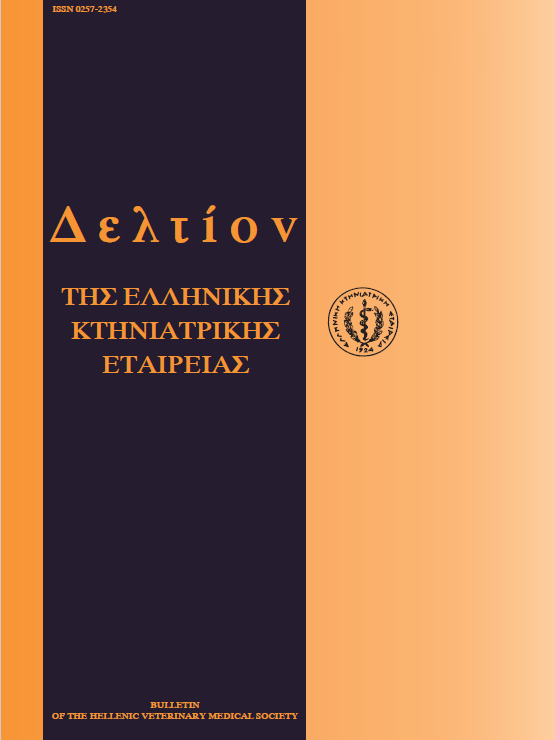Συχνότητα εμφάνισης της ελλιπούς μεταφοράς ανοσοσφαιρινών σε μόσχους φυλής Holstein στη Βόρεια Ελλάδα και συσχέτισή της με διαχειριστικά πρότυπα

Περίληψη
Η παρούσα έρευνα αποσκοπούσε στη διερεύνηση της συχνότητας εμφάνισης ελλιπούς παθητικής μεταφοράς ανοσοσφαιρινών σε μόσχους στη Βόρεια Ελλάδα και στη συσχέτισή της με πιθανούς παράγοντες κινδύνου. Συλλέχθηκαν δείγματα αίματος από 437 κλινικά υγιείς μόσχους, ηλικίας >18 ωρών μέχρι 7 ημερών, σε 30 εκτροφές, στα οποία προσδιορίστηκε με διαθλασίμετρο η συγκέντρωση ολικών πρωτεϊνών στο ορό του αίματος. Στη μελέτη χρησιμοποιήθηκαν δύο διαφορετικά όρια: 5,2 και 5,5 g dL-1. Ένας μόσχος θεωρήθηκε ότι είχε έλλειψη επαρκούς παθητικής ανοσίας όταν η συγκέντρωση ολικών πρωτεϊνών ήταν μικρότερη από τα παραπάνω όρια. Μία εκτροφή θεωρήθηκε πως αντιμετώπιζε πρόβλημα ελλιπούς παθητικής μεταφοράς ανοσοσφαιρινών όταν >20% από τους μόσχους στους οποίους είχε γίνει δειγματοληψία, είχε συγκεντρώσεις ολικών πρωτεϊνών <5,2 ή <5,5 g dL-1. Επιπλέον, δεδομένα για τα ακολουθούμενα πρότυπα διαχείρισης τηςυγείας στην εκτροφή συγκεντρώθηκαν σε σχετικό ερωτηματολόγιο, μέσω συνέντευξης με τους κτηνοτρόφους. Με όριο το 5,2 g dL-1, 20% των μόσχων και 40% των εκτροφών παρουσίασαν ελλιπή παθητική μεταφορά ανοσοσφαιρινών,ενώ με όριο το 5,5 g dL-1 τα αντίστοιχα ευρήματα ήταν 26% και 53%. Σε επίπεδο εκτροφής, η μέση συγκέντρωση ολικών πρωτεϊνών έτεινε να επηρεαστεί θετικά από την έγκαιρη χορήγηση πρωτογάλακτος, από τη διατήρηση κατεψυγμένων αποθεμάτων πρωτογάλακτος και από την ύπαρξη ξεχωριστής ομάδας αγελάδων στις τελευταίες 3 εβδομάδες της ξηράς περιόδου.
Σε ατομικό επίπεδο, οι παραπάνω παράγοντες είχαν σημαντική θετική επίδραση στη συγκέντρωση των ολικών πρωτεϊνών. Ακόμη, η ποσότητα του χορηγούμενου πρωτογάλακτος και η υγιεινή του κατάσταση παρουσίασαν θετική συσχέτιση με τη συγκέντρωση των ολικών πρωτεϊνών. Συμπερασματικά, η ελλιπής παθητική μεταφορά ανοσοσφαιρινών σε μόσχους φυλής Holstein είναι συχνή στις εκτροφές της Β. Ελλάδας. Είναι εμφανές από τα αποτελέσματα της έρευνας πως πολλοί κτηνοτρόφοι δεν είναι σωστά ενημερωμένοι για τα διαχειριστικά πρότυπα που πρέπει να εφαρμοστούν ώστε να διασφαλιστεί η επαρκής παθητική μεταφορά ανοσοσφαιρινών στους μόσχους. Ως εκ τούτου, κρίνεται ιδιαίτερα σημαντική η μεταφορά γνώσης προς τους κτηνοτρόφους σχετικά με την εφαρμογή των ορθών διαχειριστικών προτύπων και ενεργειών που θα οδηγήσουν στην ελάττωση ή εξάλειψη του προβλήματος.
Λεπτομέρειες άρθρου
- Πώς να δημιουργήσετε Αναφορές
-
PANOUSIS (Ν. ΠΑΝΟΥΣΗΣ) N., KRITSEPI- KONSTANTINOU (Μ. ΚΡΙΤΣΕΠΗ-ΚΩΝΣΤΑΝΤΙΝΟΥ) M., KALAITZAKIS (Ε. ΚΑΛΑΪΤΖΑΚΗΣ) E., GIADINIS (Ν. ΓΙΑΔΙΝΗΣ) N., & VALERGAKIS (Γ.Ε. ΒΑΛΕΡΓΑΚΗΣ) G. E. (2017). Συχνότητα εμφάνισης της ελλιπούς μεταφοράς ανοσοσφαιρινών σε μόσχους φυλής Holstein στη Βόρεια Ελλάδα και συσχέτισή της με διαχειριστικά πρότυπα. Περιοδικό της Ελληνικής Κτηνιατρικής Εταιρείας, 64(3), 193–200. https://doi.org/10.12681/jhvms.15499
- Τεύχος
- Τόμ. 64 Αρ. 3 (2013)
- Ενότητα
- Research Articles
Οι συγγραφείς των άρθρων που δημοσιεύονται στο περιοδικό διατηρούν τα δικαιώματα πνευματικής ιδιοκτησίας επί των άρθρων τους, δίνοντας στο περιοδικό το δικαίωμα της πρώτης δημοσίευσης.
Άρθρα που δημοσιεύονται στο περιοδικό διατίθενται με άδεια Creative Commons 4.0 Non Commercial και σύμφωνα με την άδεια μπορούν να χρησιμοποιούνται ελεύθερα, με αναφορά στο/στη συγγραφέα και στην πρώτη δημοσίευση για μη κερδοσκοπικούς σκοπούς.
Οι συγγραφείς μπορούν να καταθέσουν το άρθρο σε ιδρυματικό ή άλλο αποθετήριο ή/και να το δημοσιεύσουν σε άλλη έκδοση, με υποχρεωτική την αναφορά πρώτης δημοσίευσης στο J Hellenic Vet Med Soc
Οι συγγραφείς ενθαρρύνονται να καταθέσουν σε αποθετήριο ή να δημοσιεύσουν την εργασία τους στο διαδίκτυο πριν ή κατά τη διαδικασία υποβολής και αξιολόγησής της.












